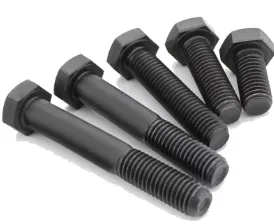Bolts: Invisible Forces Connecting the World
Aug . 13, 2025 11:29 צוריק צו רשימה
Bolts: Invisible Forces Connecting the World
In industrial production and daily life, bolts are a seemingly ordinary but crucial mechanical component. It carries the heavy responsibility of connection and fixation with a simple structure, like a hidden bond, condensing countless scattered components into an organic whole, supporting the operation of modern society.

The construction of Bolts embodies the perfect combination of simplicity and practicality
Stud bolts usually consist of two parts: a head and a screw. The head has various shapes, such as hexagonal, round, square, etc., which facilitate the application of force by the tool; The screw is machined with external threads, which can be matched with nuts with internal threads to achieve fastening between components through thread engagement. Bolts of different specifications have differences in length, diameter, thread spacing, etc., and can be flexibly selected according to connection requirements to ensure the stability and reliability of the connection.
The material selection of Bolts is closely related to their properties
Ordinary double end stud bolts are often made of carbon steel, which has a lower cost and is suitable for general stress scenarios; For high demand industrial fields, alloy steel bolts are used, which have high strength, corrosion resistance, high temperature resistance and other characteristics, and can maintain good connection performance in harsh environments. In addition, stainless steel bolts are widely used in humid and corrosive environments, such as marine engineering and chemical equipment, due to their excellent rust prevention ability.
Bolts play an irreplaceable role in various fields
In the construction industry, it firmly connects steel structures and concrete components to ensure the stability of bridges and high-rise buildings; In mechanical manufacturing, DIN933 העקס באָלץ secure various components of the machine tool to ensure precise operation of the equipment; In the automotive industry, countless bolts maintain the overall structure of vehicles from the engine to the body, which is related to driving safety; Even furniture and appliances in daily life cannot do without the connection and fixation of Bolts. It can be said that Bolts are the fundamental components that support modern industrial systems and living facilities.
With the development of technology, Bolts is also constantly innovating and upgrading
The development of high-strength grade4.8 stud bolt has significantly improved their load-bearing capacity, meeting the higher requirements for connection strength in large-scale engineering projects; Anti loosening bolts effectively solve the problem of bolt loosening in vibration environments through special thread design or additional anti loosening devices; Intelligent Bolts are equipped with built-in sensors that can monitor the force and status of the connecting parts in real time, providing accurate data for equipment maintenance. These innovations enable Bolts to play an efficient and secure connecting role in a wider range of fields.
In summary, although small, Bolts are a key force connecting the world. It supports the orderly progress of industrial production and the stable operation of daily life with its simple structure, diverse materials, wide applications, and continuous innovation. Whether it is a grand project or a small object, it cannot be separated from the silent dedication of Bolts. In the future, with the advancement of technology, Bolts will continue to break through in performance and functionality, providing solid connectivity guarantees for the development of various fields.
Bolts FAQs
What is the difference between bolts and screws?
Bolts usually need to be used in conjunction with nuts, which can be tightened by rotating the nut (such as hexagonal bolts); And screws are usually directly screwed into the threaded holes of the connected parts (such as self tapping screws) without the need for additional nuts. Bolts typically have higher load-bearing capacity and are suitable for heavy-duty structures.
What does the performance level (such as 8.8, 10.9) on Bolts represent?
The number represents the strength level of the bolts:
The first number (such as 8): 1/100 of the ultimate tensile strength (in MPa), where 8 represents 800MPa.
The second number (such as. 8): the ratio of yield strength to tensile strength (0.8=80%).
For example, the tensile strength of grade 8.8 bolts is 800 MPa and the yield strength is 640 MPa.
Why is pre tightening necessary when installing bolts?
Pre tightening force can prevent bolts from loosening due to vibration and ensure a tight fit between the connecting surfaces
Avoid lateral sliding or gaps;
Improve fatigue resistance performance;
A torque wrench is required to control the preload force, as over tightening may cause fracture.
What are the anti loosening measures for bolts?
Common methods include:
Mechanical locking: Install spring washers and nylon locking nuts;
Friction locking: Double nuts are tightened against each other;
Adhesive fixation: Apply thread locking adhesive (such as Loctite 243);
Structural design: Use split pins or stop washers.
Will stainless steel bolts rust?
Stainless steel (such as 304, 316) has rust resistance, but may still corrode under specific conditions:
Chloride ion environment (such as coastal areas) is prone to pitting corrosion;
Galvanic corrosion: When in contact with dissimilar metals (such as carbon steel), insulation treatment is required;
Choosing 316 stainless steel or surface coating can enhance corrosion resistance.
לעצטיגע נייעס
-
Bolts for Lawn Mower Handle Supplier | OEM & Rust-Resistant
נייַעסNov.17,2025
-
Silver Screws Supplier | Corrosion-Resistant, Bulk & Custom
נייַעסNov.17,2025
-
Cabinet Bolts Supplier | OEM, Bulk Stock, Fast Shipping
נייַעסNov.17,2025
-
Axle Nuts Supplier - OEM-Grade, ISO-Certified, Fast Delivery
נייַעסNov.17,2025
-
Wire Bolts Suppliers – OEM Factory Prices, ISO Quality
נייַעסNov.11,2025
-
Bolts for Lawn Mower Handle Supplier – OEM & Anti‑Rust
נייַעסNov.11,2025
